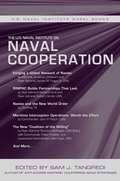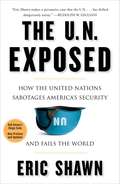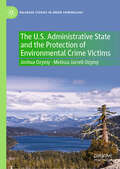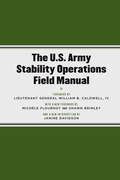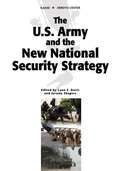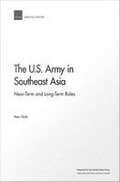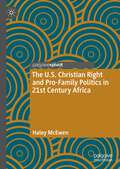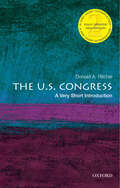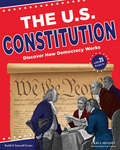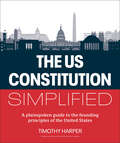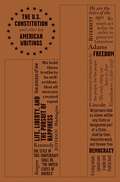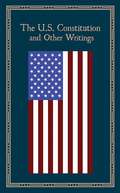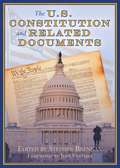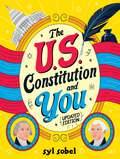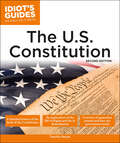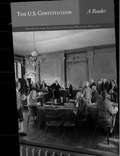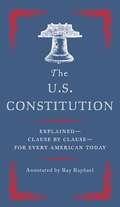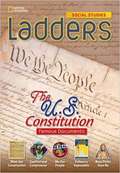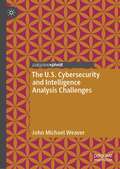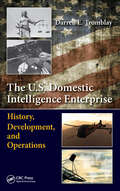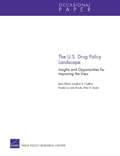- Table View
- List View
The U. S. Naval Institute On International Naval Cooperation
by Sam TangrediInternational naval cooperation encompasses the interaction of the U. S. Naval Services with the navies and militaries of treaty allies and partners nations in support of mutual defense. In addition, the term can be used to define other bilateral and multilateral defense and diplomatic activities affecting naval affairs, such as international law, rules of engagement, and arms control. Activities in support of mutual defense include bilateral and multilateral exercises, international programs such as cooperative acquisition and foreign military sales, combined training, and efforts towards increased interoperability. This volume presents an introductory discussion and selections from Naval Institute books and articles that concern these and other aspects of international naval cooperation. All naval professionals--without exception--encounter, directly participate, or play a supporting role in naval cooperation. Most apparent roles are those of foreign liaison assignments or service on alliance staffs, such as NATO staffs. But coalition operations have become the norm, and fighting alongside foreign navies is an expected aspect of current and future naval warfare. International military and naval cooperation is a specifically defined element of current U. S. national security strategy and codified in joint and Service doctrine. Obviously, an understanding of the subject is necessary in order to carry out the strategy. As part of the Naval Institute Wheel Book series, International Naval Cooperation is intended to provide a basic familiarization to all aspects of the subject and detailed understanding of relevant recent issues and development. Since there current exists no formal training on the subject for naval professionals--with the exception of certain specialized personnel--the book is designed to bridge the existing gap in knowledge. Such knowledge is as important for sea-going officers and sailors as those serving on staffs--perhaps more so, since it is at sea that cooperation brings practical results. In articles, interviews and speeches, recent Chiefs of Naval Operations have pointed to the need for high levels of pre-operational understanding and trust between allies and naval partners by using the admonition "you cannot surge trust. ” Knowledge of naval cooperative programs is the first step towards being able to build such trust. And this book builds that knowledge.
The U.N. Exposed
by Eric ShawnLess than five miles from Ground Zero in Manhattan sits an international hotbed of anti-Americanism. The United Nations was created after World War II to promote peace and international understanding. But over the years, and today more than ever, the U. N. has failed to achieve its original mission. It has failed to address the most dangerous threats facing the civilized world, refused to condemn terrorist acts, encouraged America's enemies, and supported some of the world's most oppressive governments, all while wasting billions of dollars. As veteran reporter Eric Shawn of Fox News Channel points out, the U. N. 's iconic skyscraper is where our so-called allies all too often undermine the United States and our vital interests. And for the honor of hosting our adversaries in our own country, Americans pay a whopping 22 percent of the U. N. 's bloated budget. The U. N. Exposed will give you a rare insider's tour of the United Nations, focusing on many disturbing aspects that have been ignored by the mainstream media. You will learn, for instance: how U. N. -supervised funds were diverted into weapons used against American troops how terrorists and rogue states seeking nuclear weapons flout toothless U. N. resolutions how our allies' selfish economic interests drive U. N. -backed challenges to America's sovereignty how kickbacks, bribes, and corruption have pervaded the highest echelons of the U. N. how U. N. ambassadors and staff enjoy luxurious and tax-free Manhattan lifestyles and other perks how U. N. workers have repeatedly turned children into their sexual prey As Shawn declares in his introduction, "I am disgusted by the fact that the altruistic efforts of so many U. N. staff members are undercut by the greed, corruption, and ineptitude of the bureaucracy they serve. " .
The U.S. Administrative State and the Protection of Environmental Crime Victims (Palgrave Studies in Green Criminology)
by Joshua Ozymy Melissa Jarrell OzymyThis accessible book provides the first comprehensive analysis of environmental crime victims within criminal prosecutions in the United States. By combining empirical analysis of criminal investigations undertaken by the U.S. Environmental Protection Agency from 1983-2022 with narrative discussion of numerous related criminal prosecutions, it provides novel insights to help advance a stronger empirical understanding of how the administrative state protects victims of environmental harm, punishes environmental offenders, and aids in furthering the development of an environmental victimology.
The U.S. Army Stability Operations Field Manual: U.S. Army Field Manual No. 3-07
by Caldwell Iv William Flournoy Michele Brimley Shawn Davidson JanineField Manual 3-07,Stability Operations, represents a milestone in Army doctrine. With a focus on transforming conflict, managing violence when it does occur and maintaining stable peace,The U. S. Army Stability Operations Field Manual(otherwise known as FM 3-07) signals a stark departure from traditional military doctrine. The Army officially acknowledges the complex continuum from conflict to peace, outlines the military's responsibility to provide stability and security, and recognizes the necessity of collaboration, coordination, and cooperation among military, state, commercial, and non-government organizations in nation-building efforts. The manual reflects a truly unique collaboration between the Army and a wide array of experts from hundreds of groups across the United States Government, the intergovernmental and non-governmental communities, America's allies around the world, and the private sector. All branches of the armed forces, U. S. agencies ranging from the State Department to Homeland Security to Health and Human Services, international agencies from the United Nations to the Red Cross to the World Bank, countries from the United Kingdom to India to South Africa, private think tanks from RAND to the United States Institute of Peace to the Center for New American Security, all took part in the shaping of this document. The U. S. Army Stability Operations FieldManual,marks just the second time in modern history that the U. S. Army has worked with a private publisher to produce a military doctrinal document. Lieutenant General William B. Caldwell, IV is Commander of the Combined Arms Center at Fort Leavenworth, Kansas. Michèle Flournoy, Under Secretary of Defense for Policy Shawn Brimley, Fellow, Center for a New American Security Janine Davidson, Deputy Assistant Secretary of Defense for Plans "It is a roadmap from conflict to peace, a practical guidebook for adaptive, creative leadership at a critical time in our history. It institutionalizes the hard-won lessons of the past while charting a path for tomorrow. This manual postures our military forces for the challenges of an uncertain future, an era of persistent conflict where the unflagging bravery of our Soldiers will continue to carry the banner of freedom, hope, and opportunity to the people of the world. " -From the foreword by Lieutenant General William B. Caldwell, IV, Commander of the Combined Arms Center at Fort Leavenworth, Kansas
The U.S. Army and the New National Security Strategy
by Nora Bensahel Lynn E. Davis Roger Cliff Bruce Nardulli Jeremy ShapiroThis book examines the Army's role in the war on terrorism; the Army's homeland security needs; the implications of increased emphasis on Asia; the Army's role in coalition operations; the unfinished business of jointness-the lessons learned from operations and how to prepare for the future; the Army's deployability, logistical, and personnel challenges; and whether the Army can afford its Transformation. These examinations are bracketed by an introduction, a description of the Army's place in the new national security strategy, and a summary of the authors' conclusions.
The U.S. Army in Southeast Asia: Near-Term and Long-Term Roles
by Peter ChalkThis RAND report examines the U.S. Army role in Southeast Asia. Under current benign conditions, efforts should focus on supporting defense reform, addressing transnational threats, and balancing China. If the outlook deteriorates, the United States should increase security cooperation, conclude new regional basing agreements, expand disaster assistance, and create policies to encourage risk-averse Chinese behavior.
The U.S. Christian Right and Pro-Family Politics in 21st Century Africa
by Haley McEwenThis book will address and uncover the role of US Christian Right ‘pro-family’ groups in mobilizing counter-movements against LGBTIQ+ human rights, reproductive justice, and sexuality education in Africa, and will intervene in the tendency to exceptionalize Africa as a ‘homophobic continent’ following the surge in homophobic and transphobic legislation, hate speech, and violence in recent years. The author employs the lens of decoloniality in an intersectional manner to unpack the multiple forms of hierarchy and oppression that the concept of the nuclear family has historically worked to naturalize in the interests of capitalism, Christo-normativity, and a world system dominated and controlled by the global north. Proceeding from the historical geopolitical context informing nuclear family idealization, the analysis then presents a critical discussion of contemporary pro-family discourses, showing that pro-family narratives that universalize and politicize the notion of ‘family’ are not only constituting agendas that erode LGBTIQ+ and reproductive justice, but reinforce an international order that privileges Euro-American interests despite pro-family claims that their agendas are anti-imperialist. This book will be of interest to scholars in gender, sexuality, and queer studies; postcolonial studies; and international relations.
The U.S. Congress: A Very Short Introduction
by Donald A. RitchieIn the second edition of The U.S. Congress, Donald A. Ritchie, a congressional historian for more than thirty years, takes readers on a fascinating, behind-the-scenes tour of Capitol Hill, pointing out the key players, explaining their behavior, and translating parliamentary language into plain English. No mere civics lesson, this eye-opening book provides an insider's perspective on Congress, matched with a professional historian's analytical insight. After a swift survey of the creation of Congress by the constitutional convention, he begins to unscrew the nuts and pull out the bolts. What is it like to campaign for Congress? To attract large donors? To enter either house with no seniority? He answers these questions and more, explaining committee assignments and committee work, the role of staffers and lobbyists, floor proceedings, parliamentary rules, and coalition building. <P> Ritchie explores the great effort put into constituent service-as representatives and senators respond to requests from groups and individuals-as well as media relations and news coverage. He also explores how the grand concepts we all know from civics class--checks and balances, advise and consent, congressional oversight--work in practice in an age of strong presidents and a muscular Senate minority.
The U.S. Constitution
by Carla MooneyWhere did the American democratic tradition begin? From ancient civilizations in Greece and Rome to the Enlightenment in Europe, democratic ideas throughout time have influenced the development of democracy in the United States. In The U. S. Constitution: Discover How Democracy Works, children ages 9 through 12 learn about the foundation of democracy and how the documents crafted hundreds of years ago still have an impact on our country today. They explore the Declaration of Independence, U. S. Constitution, and the Bill of Rights, among others. These documents provide a framework with which we make the laws and processes that help keep democracy a vital paradigm. Through hands-on projects, which include analyzing how the promises made in the Preamble of the Constitution were put into practice and investigating how to balance the freedom of speech in the digital age, students investigate how American democracy operates. With colorful illustrations, interesting sidebars, and links to online primary sources, this book asks readers to consider the effect of technology on democracy and make predictions about future documents that will be important to the preservation of democracy around the world.
The U.S. Constitution (Cornerstones of Freedom: Third Series)
by Michael Burgan Gordon Purcell Terry BeattyLearn about the history of the U.S. Constitution, its primary functions, how it has changed over the years, and why it is still important today. <P><P>Even before the first glorious ring of the Liberty Bell, America was a land of freedom and promise. The Cornerstones of Freedom series explores what inspires people from all over the world to start life anew here, endure the economic and social upheavals, and defend the land and rights that are unique to the United States of America.
The U.S. Constitution Simplified: A plainspoken guide to the founding principles of the United States
by Timothy HarperWhat does the US Constitution mean for you?One of the most revered, imitated, and controversial governmental documents in the world, the US Constitution serves as the foundation for the American government and shapes the lives of Americans every day. But what do you know about its history and the impact it has on guiding an ever-evolving nation? This book provides a clear look at the single document that defines America, including the birth of the Constitution and the history and details of its amendments.This revision covers recent court rulings related to the Constitution and how those decisions have ramifications for everyday Americans. If you've never fully read the Constitution before, this guide will give you an opportunity to learn about the most influential document in US history.
The U.S. Constitution and Other Key American Writings (Wordsworth Classics)
by AnonymousThe U. S. Constitution and Other Key American Writings is part of the Word Cloud Classics series and a collection of the crucial documents that established the United States. In addition to the Constitution, readers can study supplementary texts like the Declaration of Independence, the Articles of Confederation, the Federalist Papers, and even important speeches by early presidents. The Founding Fathers’ inspirational and revolutionary ideals are all included in these doctrines, and this is a perfect volume for anyone who finds the history of America to be a fascinating and enlightening journey. Lexile score: 1600L
The U.S. Constitution and Other Writings (Leather-bound Classics)
by Editors of Thunder Bay Press Kenneth C. Mondschein“We the People of the United States, in order to form a more perfect union . . . ” — The U.S ConstitutionThe U.S. Constitution and Other Writings is part of the Leather-bound Classics series and is a collection of the crucial documents, speeches, and other writings that shaped the United States. In addition to the Constitution, readers can review the Declaration of Independence, the Articles of Confederation, the Federalist Papers, important presidential speeches, and many others. Both famous and lesser-known, but equally important, Americans are represented, including Benjamin Franklin, Victoria Woodhull, Frederick Douglass, Susan B. Anthony, and even the creators of the rules of baseball. The founders' inspirational and revolutionary ideals are all here, and this is a perfect volume for anyone who finds the history of America to be a fascinating and enlightening journey.
The U.S. Constitution and Related Documents
by Jesse Ventura Stephen BrennanNo matter who you identify with—Democrat or Republican, Tea Party or Green Party, Independent or something else altogether—we the people should read: The Constitution of the United States of America The Bill of Rights and all of the Amendments The Declaration of Independence The Articles of ConfederationTake a moment or two to reflect on the words of our forefathers, as these are the documents literally created America. The Constitution set up a system of government that remains centuries later. The eloquent words of The Declaration of Independence are an enduring statement of human rights. Written and signed by Benjamin Franklin, Thomas Jefferson, George Washington, and other great lights of our historical past, these documents define our freedoms and promise us our futures. And while they are often quoted, they are seldom actually read. Here is an opportunity to reach a new audience, with a fresh design and the same inspiring words. This collection will be a welcome addition to any American who believes in the dream.
The U.S. Constitution and You
by Syl Sobel J.D.This easy-to-read book about the United States for kids brings history and social studies classes to life as readers learn about the U.S. Constitution. Here is a book that will be valued by teachers and enjoyed by young students.Parents, teachers, and gift givers will find:a clear explanation of the Constitutionvocabulary words that align with curriculuma book that makes the Constitution relevant to kids' livesDo you know how the U.S. Constitution works to protect you, your friends, and your family? It gives you and every American citizen many rights including the right to vote, as well as to enjoy freedom of speech, freedom of the press, freedom to worship—or not worship—according to your beliefs, to disagree openly with government policy, and to defend yourself in courts of law. You'll learn about our rights as a citizen...and also learn which rights are reserved for the state and the community where you live.
The U.S. Constitution and You
by Syl Sobel J.D.Newly updated edition!Discover everything you need to know about the law of the land in this fact-packed introduction to the United States Constitution!The U.S. Constitution and You is an easy-to-read guide to the most important document in American history. Readers will learn all about the history of the Framers and how the Constitution came to be, as well as important concepts like the three branches of government, checks and balances, amendments, and so much more!
The U.S. Constitution, 2nd Edition (Idiot's Guides)
by Timothy HarperOne of the most revered, imitated, and controversial governmental documents in the world, the U.S. Constitution serves as the foundation for the American government and shapes the lives of Americans every day. Yet, how many of us know its history and the impact it has on guiding our ever evolving nation? Idiot's Guides: The U.S. Constitution, Second Edition, provides you a clear look at the one single document that defines America. Suitable supplemental reading for students in high school government/civics classes and college political science classes, this guide covers the birth of the Constitution and the history and details of its amendments.
The U.S. Constitution: A Reader
by Hillsdale College Politics FacultyFeaturing 113 primary source documents, The U.S. Constitution: A Reader was developed for teaching the core course on the U.S. Constitution at Hillsdale College. Divided into eleven sections with introductions by members of Hillsdale's Politics Department faculty, readings cover: -the principles of the American founding; -the framing and structure of the Constitution; -the secession crisis and the Civil War; -the Progressive rejection of the Constitution; and -the building of the administrative state based on Progressive principles. America's Founders created a form of government which had, in the words of James Madison, "no model on the face of the earth." Its moral foundation is in the Declaration of Independence and its principle of equal natural rights. Under the Constitution, government was to be limited to protecting those rights. In recent decades, the way our government operates has departed from the Constitution. Government has become less limited, and our liberties less secure. At the same time, true civic education in America--education in the Constitution--has largely died out. We at Hillsdale College see it as one of our highest duties to reverse this.
The U.S. Constitution: Discover How Democracy Works
by Tom Casteel Carla MooneyWhere did the American democratic tradition begin? From ancient civilizations in Greece and Rome to the Enlightenment in Europe, democratic ideas throughout time have influenced the development of democracy in the United States.In The U.S. Constitution: Discover How Democracy Works, children ages 9 through 12 learn about the foundation of democracy and how the documents crafted hundreds of years ago still have an impact on our country today. They explore the Declaration of Independence, U.S. Constitution, and the Bill of Rights, among others. These documents provide a framework with which we make the laws and processes that help keep democracy a vital paradigm.Through hands-on projects, which include analyzing how the promises made in the Preamble of the Constitution were put into practice and investigating how to balance the freedom of speech in the digital age, students investigate how American democracy operates. With colorful illustrations, interesting sidebars, and links to online primary sources, this book asks readers to consider the effect of technology on democracy and make predictions about future documents that will be important to the preservation of democracy around the world.
The U.S. Constitution: Explained for Every American
by Ray RaphaelPoliticians come and go, but the Constitution stands as the supreme law of the land. Setting forth the workings of our democracy, it is the bedrock document from which we derive our policies on topics as diverse and galvanizing as immigration, gun ownership, voting rights, taxation, policing, civil liberties, and war. In this indispensable edition, acclaimed historian and Constitutional expert Ray Raphael guides us through the origins, impact, and current relevance of the original text and all twenty-seven amendments. Here is the key historical context for issues in the news today—from the Electoral College to Washington gridlock, from peaceful protests to executive power. Thoughtful and nuanced, lively and highly readable, this annotated Constitution is for all of us to read and refer to—the ultimate political fact-checking source for every American.
The U.S. Constitution: Famous Documents [On-Level] (Ladders Social Studies 5)
by Anne Goudvis Andrew MilsonNIMAC-sourced textbook <P><P>Articles for the National Geographic Famous Documents Series. Articles include Meet the Constitution, We the People and Rosa Parks says no.
The U.S. Cybersecurity and Intelligence Analysis Challenges
by John Michael WeaverOne of the prevailing issues regarding security to North America and more pointedly, the United States, gravitates on the topic of cyber threats confronting this nation. These threats are becoming more disruptive and destructive and many nations’ infrastructure is vulnerable to them. This book makes use of a qualitative research methodology looking at a conventional understanding of the four instruments of power that include diplomacy, information, military and economic (D.I.M.E.) efforts through the use of the York Intelligence Red Team Model-Cyber (Modified) and seeing how adversaries are using them against the United States. Moreover, this project uses secondary data and makes use of the Federal Secondary Data Case Study Triangulation Model to ensure a balance of sources to dissect the problem.
The U.S. Domestic Intelligence Enterprise: History, Development, and Operations
by Darren E. TromblayMuch has been written about U.S. intelligence operations. However, intelligence, as it is conducted in the U.S. domestic environment, has usually been treated in a fractured and sensationalistic manner. This book dispassionately assesses the U.S. domestically oriented intelligence enterprise by first examining its individual components and then sho
The U.S. Drug Policy Landscape: Insights and Opportunities for Improving the View
by Peter H. Reuter Beau Kilmer Rosalie Liccardo Pacula Jonathan P. CaulkinsDiscussions about reducing the harms associated with drug use and antidrug policies are often politicized, infused with questionable data, and unproductive. This paper provides a nonpartisan primer on drug use and drug policy in the United States. It aims to bring those new to drug policy up to speed and provide ideas to researchers and potential research funders about how they could make strong contributions to the field.
